The Day Lincoln Was Almost Shot
The Fort Stevens Story
Benjamin Franklin Cooling author
Format:Paperback
Publisher:Rowman & Littlefield
Published:27th Apr '15
Currently unavailable, our supplier has not provided us a restock date
This paperback is available in another edition too:
- Hardback£59.00(9780810886223)

The Day Lincoln Was Almost Shot: The Fort Stevens Story recounts the story of President Abraham Lincoln’s role in the Battle of Fort Stevens in July 1864. This engagement stands apart in American history as the only time a sitting American president came under enemy fire while in office. In this new study of this overlooked moment in American history, Cooling poses a troubling question: What if Lincoln had been shot and killed during this short battle, nine months prior to his death by John Wilkes Booth’s hand in Ford's Theater? A potential pivotal moment in the Civil War, the Battle of Fort Stevens could have changed—with Lincoln's demise—the course of American history. The Day Lincoln Was Almost Shot, however, is more than a meditation on an alternate history of the United States. It is also a close study of the attempt by Confederate general Jubal Early to capture Washington, DC, to remove Lincoln and the Union government from power, and to turn the tide of the Civil War in the South's favor. The dramatic events of this attempt to capture Washington—and the president with it—unfold in stunning detail as Cooling taps fresh documentary sources and offers a new interpretation of this story of the defense of the nation’s capital. Commemorating this largely forgotten and under-appreciated chapter in the study of Lincoln and the Civil War, The Day Lincoln Was Almost Shot is a fascinating look at this potential turning point in American history.
Most Civil War buffs are aware that Lincoln came under Confederate fire, and this work presents all the details they could wish to learn about the incident. It occurred in July 1864, when the president traveled to one of Washington’s forts to see the combat that erupted when a Confederate force attacked. To prepare his readers for the narrative of the battle that Lincoln witnessed, Cooling describes the military preliminaries, which began with General Robert E. Lee’s dispatching a force to threaten Washington. Recounting its progress under its commander, Jubal Early, Cooling runs through its march through Maryland, victory at the Battle of Monocacy, and approach toward the defenses of the federal capital. Noting the anxieties Early provoked among government leaders, Cooling recounts the reinforcements they summoned and the battle that occurred at Fort Stevens before delving into such questions as the precise location from which Lincoln observed the proceedings. After balancing witnesses’ recollections, Cooling describes the postwar memorialization of the battle site, which can be visited today—indeed, battlefield tourists will be Cooling’s best customers. * Booklist *
This is a detailed and skilled account of a faded chapter in the annals of Civil War history that should not be ignored. * Publishers Weekly *
Cooling fills the book with interesting and arcane anecdotes, using participants' words to move the narrative. . . .This is a colorful and unusual tale. * America's Civil War *
Cooling has produced a work well worth buying and reading. * On Point: The Journal of Army History *
Cooling presents an exhaustive history of pre-battle events, Lincoln’s activities at the fort, and Union troops’ courageous actions defending the capital. . . .Cooling has written what should stand as the definitive treatment of the Fort Stevens story for years to come. -- Thomas A. Horrocks, John Hay Library at Brown University, Director * Civil War News *
ISBN: 9781442252783
Dimensions: 221mm x 148mm x 25mm
Weight: 503g
366 pages